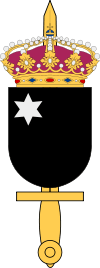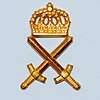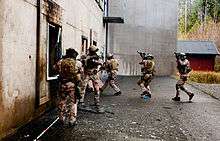Särskilda operationsgruppen
Särskilda Operationsgruppen (English: Special Operations Task Group, abbreviated SOG, literal translation: Special Operations Group.)[2] is a special operations unit within the Swedish Armed Forces which has been active since 2011. The unit is headquartered at Karlsborg Fortress in Karlsborg, Västra Götaland County.
| Special Operations Task Group | |
|---|---|
| Särskilda operationsgruppen | |
 | |
| Active | 2011–present |
| Country | |
| Allegiance | Swedish Armed Forces |
| Type | Special forces Special mission unit |
| Role | Special operations Direct action Special reconnaissance Military assistance Personnel recovery Hostage rescue Personal Security Detachment HVT raids Military assistance to civilian police |
| Size | Classified |
| Part of | Under the direct command of the Supreme Commander |
| Garrison/HQ | Karlsborg |
| Motto(s) | Framåt i natten "Forward in the night" |
| Engagements | KFOR Operation Artemis EUFOR Tchad/RCA ISAF Operation Inherent Resolve |
| Insignia | |
| Service badge[1] |  |
History
Särskilda operationsgruppen was formed in 2011 by merging the Special Protection Group (SSG) and the Special Reconnaissance Group (SIG).[3]
Organisation
The Special Operations Task Group (SOG) answers directly to the Supreme Commander and the Director Special Forces. The unit, combined with the Special Forces Command (SFL) , comprises the Swedish Armed Forces Special Forces (FM SF). In addition to this, there are several special forces support units (FM SOF). The personnel of which are specially selected, trained and equipped for air, sea and land infiltration, technical, logistical and medical support. For example, The Special Helicopter Group (SHG), Special Maritime Transportation unit (STE), Special Signals Group (SSE), and the Section for Operative Technology (SOT).
SOG consists of two so-called response units (IE). IE1 is focused on combat tasks (Direct Action) and IE2 is focused on intelligence gathering (Special Reconnaissance). IE2 is known to utilize female intelligence personnel to conduct certain HUMINT tasks.
Each SOG response unit (IE) is organized in squadrons, troops, and patrols. Three 4-man patrols make up a troop, and an unknown number of troops make up a squadron. Besides the operational elements of the unit, there is also a Training Wing, responsible for the selection and training of future and current operators. Each operator has a broader skill base than a regular soldier and one or two patrol skills at which he is exceptionally skilled. A typical SOG team consists of four operators: a team leader, a demolitions expert/breacher, a communicator, and a combat medic. Each patrol can be augmented with EOD technicians, JTAC-specialists, military working dog handlers, or snipers.
Furthermore, every soldier has an infiltration specialty in either military free fall (HALO/HAHO) or combat diving.
Role
The most frequent usage of the SOG is during multi-national special operations such as ISAF in Afghanistan or Operation Inherent Resolve in Iraq.
SOG combat operations are of great strategic importance that cannot be accomplished by conventional forces or weapon systems. Combat missions can be to eliminate high-value targets or objects of great importance to the enemy, to conduct complex rescue operations of Swedish personnel held captive or hostage, or to gather time-critical intelligence through action. SOG can also, if needed and requested, augment the police counter-terrorism assets to intervene during domestic terrorism and/or hostage crisis due to new legislation implemented in 2006.
Special reconnaissance and intelligence gathering is intended to gather information of great tactical importance about the enemy´s activities, enemy personnel or other bits of information of operational significance.
Special Forces can also be tasked with advising and training foreign military units as part of an international peace-keeping military operation.
The unit maintains a high degree of readiness and can be deployed on short notice within a 6,000 kilometres (3,700 mi) radius of Stockholm and can operate in any environment, for example, jungle, desert, mountain/alpine, sub-arctic and urban. The unit is deployed on request by the UN, EU or NATO but must then be sanctioned on a political level.
Due to operational security, the unit's capabilities, equipment, operational methods, previous or on-going operations, and the identities of their personnel are classified.
The SOG's predecessors, the SSG and SIG, participated in operations in the Balkans, Congo, Tchad and the Central African Republic. Swedish special forces have also been continuously deployed in Afghanistan from the beginning of the conflict up until the withdrawal of ISAF forces in 2014. From 2015 a contingent of around 30 operators from the SOG along with support elements has been participating in Operation Inherent Resolve, acting as advisors for Kurdish Peshmerga forces.
Selection and training

Selection is open for Armed Forces members of both sexes who are at least eligible for specialist officer's training.
The candidates are advised to prepare themselves at least six months prior to the selection course and are invited to attend a pre-selection weekend where they will be tested and advised on their likelihood of success or failure and also where they need to improve.
The selection process takes 2–3 weeks and is held once a year. Historically, candidates for SOG’s predecessors, the SSG and SIG, were sought out by the unit and invited to attempt selection. Selection for SOG, however, is advertised on the Armed Forces website and at unit garrisons and is open for anyone who meets the basic requirements.
The selection consists of an extremely grueling field exercise, stretching over more than a week, where the candidates are tested on their fitness, fieldcraft and land navigation and the tests are conducted during great stress. The second week consists of psychological tests, similar to those undertaken by fighter pilots. They are also tested for their predisposition for phobias, such as heights and confined spaces. Typically, selection has a roughly 10% pass rate. If the candidate is successful, he/she will begin the basic operator course which lasts for 12 months and is divided into three blocks:
- Basic combat skills
- Patrol skills
- Specialist skills
Once completed, the operator will be put in an operational patrol within a troop and can be deployed with the unit.
Personnel applying to join the unit as EOD or JTAC operators undergo the same selection process as the normal operators but do a shorter eight month basic operator course, after which they continue with specialist training in the EOD or JTAC function.
Operators train at their own compound at a secret location near Karlsborg, which, among shooting ranges, also features a large multi-story CQB-building, with bullet-absorbing lining in its walls. The building also facilitates helicopter insertions on its roof. Much of their training is also conducted internationally, often alongside the special forces units of Sweden's NATO partners.
Equipment and armament
The SOG differs greatly from the rest of the Swedish Armed Forces in its equipment and armament. The most noticeable difference is their usage of Multicam rather than M90. Operators wear combat uniforms from Crye Precision or Arcteryx, a wide variety of different plate carriers and Ops Core FAST ballistic helmets.[4]
Besides the differences in equipment, the SOG also issues different firearms than the conventional military as well, with the standard Ak 5, support weapons such as machine guns and anti-armor weapons also differ from those usually employed by the conventional military.
SOG operators are issued most prominently LWRC rifles in both 5.56 and 7.62[5], as well as the CBJ-MS PDW. The standard issue handgun of the unit is the Glock 17.[6]
Heraldry
The SOG coat of arms is blazoned thus: Upon a black shield is a six-pointed star in silver in the upper dexter corner. The field is crowned with the royal crown and laid upon a towering sword of gold. [7]
The coat of arms was developed by the Armed Forces Board of Traditions and symbolizes the unit's ability of unconventional problem solving, the effectiveness of duty and clandestine operations, and the asymmetrically positioned star symbolizes asymmetric warfare.
The unit insignia, worn by each operator on the combat uniform consists of a winged Norse dagger Seax with an asymmetrically positioned six-pointed star.
Personnel within the Swedish Special Operations Forces, SOG and its support units also wear an olive green beret with a black, embroidered cap badge, the only non-metal cap badge within the Swedish Armed Forces. It is normally worn in public only by the commanding officer of SOG, a brigadier general, since the identities of all the operatives are classified.
Similar units
See also
References
- "1.2.23.1 Uniform m/87 grå för SOG". Reglemente: uniformsbestämmelser 2015 : Unibest FM 2015 (in Swedish). Stockholm: Försvarsmakten. 2015. SELIBR 19513428.
- "Special forces - Försvarsmakten.se". Försvarsmakten. Archived from the original on 26 August 2012. Retrieved 11 September 2012.
- "Under ytan på specialförbanden". Försvarsmakten. 10 December 2010. Retrieved 14 December 2010.
- Enander, Dag. "Omedelbart operativa". Försvarsmakten (in Swedish). Retrieved 31 March 2019.
- "BREAKING: Swedish SOG and Special Police units to get LWRCI Rifles -". The Firearm Blog. 29 November 2016. Retrieved 31 March 2019.
- Enander, Dag. "Omedelbart operativa". Försvarsmakten (in Swedish). Retrieved 31 March 2019.
- https://web.archive.org/web/20111106094333/http://www.forsvarsmakten.se/sv/Forband-och-formagor/Specialforband/Nyheter/Nytt-heraldiskt-vapen/